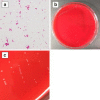Streptobacillus moniliformis bacteremia in a rheumatoid arthritis patient without a rat bite: a case report
- PMID: 26584844
- PMCID: PMC4653872
- DOI: 10.1186/s13104-015-1642-6
Streptobacillus moniliformis bacteremia in a rheumatoid arthritis patient without a rat bite: a case report
Abstract
Background: Rat bite fever is a relatively rare infectious disease due to infection with Streptobacillus moniliformis or Spirillum minus mainly via directs bite by rats, mice, or other rodents. If there is no clear bite history, the diagnosis is difficult or may not be made.
Case presentation: A 72-year-old Asian female with rheumatoid arthritis was admitted for high grade fever and walking difficulty with severe lumbago. Initially, we suspected lumber compression fracture with deterioration of rheumatoid arthritis, but Gram-negative bacilli were isolated from blood culture during hospitalization. The isolated organism was identified as S. moniliformis by 16S ribosomal ribonucleic acid (rRNA) sequencing. S. moniliformis is well known to be a primary causative organism of rat bite fever, but this patient had no history of rat bite. Had S. moniliformis bacteremia not been detected, she might have been treated for rheumatic exacerbation.
Conclusion: We emphasize the importance of performing appropriate microbial culture testing for identifying potential infectious diseases. We also conclude that S. moniliformis infection can become established with contaminated vehicle contact alone, not only as a direct result of a bite. We must keep mind that those working in places where rodents breed or are at risk of contact with rats or mice might be at risk for contracting this unusual disease.
Figures


References
Publication types
MeSH terms
Substances
LinkOut - more resources
Full Text Sources
Other Literature Sources
Medical
Molecular Biology Databases
Miscellaneous

